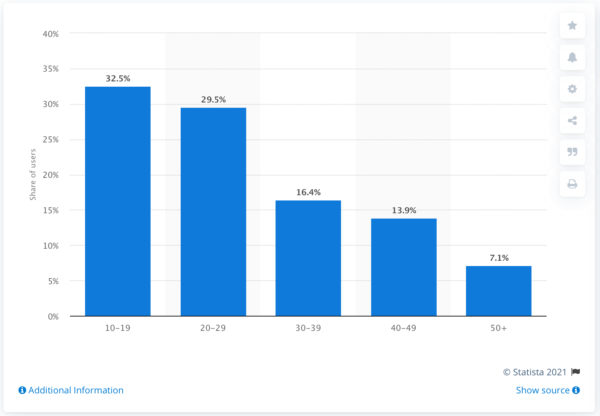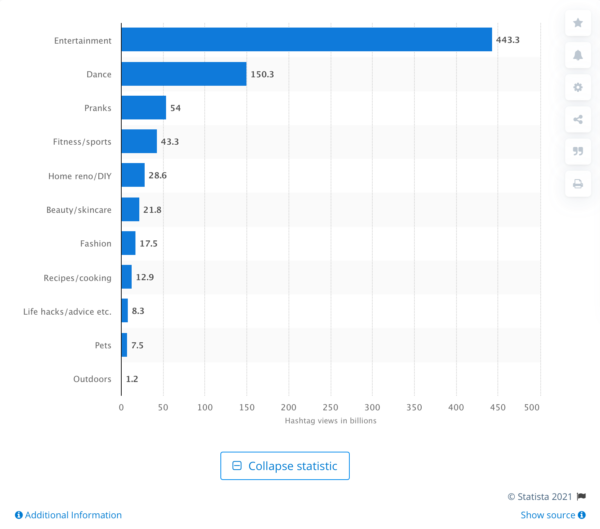
Are you thinking about expanding your social media marketing efforts to the world of TikTok?
If so, you couldn’t have picked a better time. This social network only launched a few years ago, but it hit the ground running. Despite its impressive growth, however, the advertising and marketing landscape is still wide open. There are many opportunities to gain a foothold here.
Just how popular is TikTok? The word “extremely” comes to mind. TikTok was the most downloaded app in the world in 2020, according to several sources.
If the TikTok craze still feels like a bit of a mystery, not to worry. This guide will help you understand why more than 600 million active users fire up the app each month, how you can get your brand messaging in front of them, and why you should.
What is TikTok?
TikTok is a social network built around video sharing.
Many of the first TikTok users migrated from Vine, a video-sharing platform that focused on 6-second looping micro-videos, which shut its doors abruptly in 2017. One of these Vine transplants is Zach King. He is now one of TikTok’s most prolific posters, and one of its most popular — King boasts more than 56 million followers.
Similar to Vine, most TikTok content consists of short video clips. You’ll find lip-sync videos, make-up tutorials, viral dance trends, political commentary, and more cat videos than you could watch in a lifetime.
In terms of content, the service is similar to YouTube, but the social media elements are closer to Instagram. TikTok feeds scroll by very quickly and are extremely varied.
TikTok video guidelines and rules
TikTok offers users an endless stream of content about, well, just about anything. The service does expect users to adhere to several overarching guidelines and rules, however.
Creating and interacting on TikTok: the basics
Each individual TikTok video clip is limited to 15 seconds, but videos can be combined for a total of 60 seconds. TikTok users can create original content, add effects and background music to videos, and modify existing videos as long as they don’t breach copyright laws.
For example, you might see videos pop up in your feed that feature users dancing to background music. Often, you’ll notice trends where thousands of users post their own videos where they dance to the same song.
Much like Instagram and Facebook, as users scroll through their feed they can “like,” comment on, and share videos on their own feeds, or through direct messages, text messages (aka SMS), and other communication tools. TikTok users assign hashtags to categorize content so that it can be discovered by anyone on the platform.
Take note! From an engagement perspective, TikTok beats out all other social platforms across accounts of all sizes.
TikTok users also tend to stick around longer with each visit. Users typically interact with TikTok for around 52 minutes per day, while Facebook users engage for around 38 minutes, and Instagram users spend about a half-hour per day on that platform.
Clearly, marketers who create the ideal blend of entertainment and savvy branding have the potential to reach millions of engaged, active users in a unique way. You’ll more than likely experience a learning curve as you work to hit the right notes, but investing the time to study the TikTok market will make a big difference.
Before you get started on your first TikTok campaign, set up an account and just observe for a while. It’s hard to define what makes TikTok “tick,” but you can develop a feel for the culture by interacting with the community for a few days.
TikTok marketing opportunities
TikTok has grown rapidly, but its advertising market isn’t as saturated as social networks like YouTube and Facebook.
Monetization has not yet caught on in the same way for content creators. Third-party marketing exists on TikTok, but there are far fewer brands competing for a share of the potentially lucrative TikTok market.
From a brand marketing perspective, there’s still time to get in early at a relatively low cost.
TikTok demographic trends
If your brand isn’t targeted to the teen demographic exclusive, TikTok may not seem like an ideal fit.
Many people still think of this social media platform as a Gen Z mainstay. True, it is popular among this age group, but TikTok’s massive growth represents users of all ages and demographics. Nearly 40% of US-based TikTok users are older than 30.
TikTok users represent just about any demographic imaginable, but you should become familiar with its core audiences. The platform’s biggest following is part of Generation Z — specifically, people under age 30. This group represents about 60% of the current TikTok user base.
Distribution of TikTok users in the United States as of June 2020, by age group (Source: Statista)

While TikTok certainly skews toward a younger audience, don’t discount this social platform if your target demographic is a bit older. People over 30 make up at least 37% of the TikTok user base and their numbers seem to be growing.
Here are a few other key demographics to keep in mind when developing TikTok marketing content:
- 56% of users identified as male and 44% as female — however, the platform does not currently allow users to select genders beyond male and female
- About half (52%) of users access the platform from iOS (Apple) devices and almost half (47%) use Android devices
- TikTok is available in 150 markets and 75 languages
Popular content categories on TikTok
You’ll also want to develop a rich understanding of the most popular content categories on TikTok. As you can see, the entertainment category far outpaces other categories across the platform.
Most popular content categories on TikTok worldwide as of June 2020, by number of hashtag views (Source: Statista)

This ranking is determined by comparing hashtag views on TikTok. Hashtags that fall under the Entertainment category were used more than 440 billion times, collectively. The next category, Dance, includes around 150 billion collective hashtag views.
These are broad categories, but they are informative when it comes to creating content and launching new marketing campaigns, no matter which tactic you choose.
Don’t worry if your brand doesn’t feel like it fits within one of the more popular categories. Keep in mind that these categorizations describe the style of the video as much as its actual content.
Videos that fall under the Entertainment category, for example, could be focused on content about a TV show, or they could simply be entertaining in an original way. Still, this data tells us that users go to TikTok for entertainment much more frequently than they visit looking for content focused on fashion.
How to market on TikTok
TikTok marketing generally falls into three categories: influencer marketing, original content creation, and TikTok ads. Your brand’s style, capabilities, and goals will all factor in when deciding which tactic to try, or whether you might benefit more from a mix of all three.
Influencer marketing on TikTok
Influencer marketing, sometimes called influencer targeting, identifies the type of word-of-mouth recommendations that can spread rapidly across social media.
Effective influencers include celebrities, brand ambassadors, niche promoters, and regular people who have developed their own followings.
The primary role of the influencer is to endorse products and services in a way that prompts consumers to move ahead with a purchase. As business growth expert Jay Baer says, “True influence drives action, not just awareness.”
To get the most from influencer marketing attempts, brands must garner the support of social media influencers who can go beyond exposing your brand to their followers (though exposure can certainly be beneficial in its own right).
The kind of content that is most popular on TikTok — think makeup tutorials and cooking videos — is well-suited for influencer marketing among TikTok users who have large followings.
In order to have an influencer promote your product or service, you’ll need to partner with them. In other words, you’ll need to pay them to share content about your brand with those large followings.
Don’t discount the potential benefits your brand stands to gain from influencer marketing on TikTok. One in three consumers say they trust influencer opinions more than direct brand promotion.
Selecting the right influencer
When it comes to influencer marketing, remember, relevance is more important than reach.
Any TikTok user with millions of followers may seem like an obvious choice, but you could wind up making a huge investment in an influencer relationship that won’t be of much benefit to you.
Spend time exploring how your niche is represented on TikTok and start with influencers who feel authentic in that space. Here’s an easy plan:
- Navigate to the Discover tab and search for keywords related to your product, service, industry, or niche.
- Make a list of TikTok users that have the largest followings or who have posted the most popular and shared videos.
- Work through your list and narrow it down to a few potential influencers — the ones who feel like the best fit for your brand.
Tip: You can also use the Discover tab to see videos associated with your chosen keywords across all categories. This can help if you’re thinking of developing your own content or for brainstorming with your chosen TikTok influencers.
A note about micro-influencers
Don’t discount potential influencers who have limited followings if they have one or two extremely popular videos. These are the TikTok users that you may be able to work with at a bargain before their popularity explodes.
Creating original TikTok content
TikTok is beloved among its users because the platform is brimming with unique content that is unlikely to originate anywhere else.
In some ways, the simple style of homegrown content popular on TikTok may seem more simplistic than it actually is. It can take hours to create tiny video clips that connect with the TikTok audience and hopefully go viral.
That’s not to say content creation isn’t worth your effort. It’s just important to go in well-armed with the knowledge of what it takes to trend on TikTok.
Going viral
You can explore the “trend culture” on TikTok by applying the same technique we already outlined for finding your ideal influencers.
The Discover tab allows you to track trending hashtags related to your product and brand. Dedicate some time to working through the biggest trending videos in your niche and brainstorm over how you can get in on the action.
This is a great opportunity to pull in friends and coworkers. By gauging their reactions, you may have a better chance of going viral.
Be mindful of your video’s overarching style. TikTok users love humorous videos that lean toward the silly and absurd, but it’s all too easy to overshoot.
The last thing your brand needs is for you to go viral for all the wrong reasons.
Three TikTok trends that went viral in 2020
Your TikTok content should be original, but you don’t need to reinvent the wheel.
Draw inspiration from previous TikTok trends. They may seem random when you consider what’s been popular on the platform. However, it is more likely that there are patterns to be found across your niche.
Cranberry dreams
Nathan Apodaca launched a wildly popular trend on TikTok in 2020 that actually included a branded product (Ocean Spray Cran-Raspberry juice), though he appears to have no official link to the brand.
In the video, Apodaca skates down a street while drinking straight from a bottle of the juice. Fleetwood Mac’s “Dreams” plays in the background and Apodaca charmingly lip-syncs some of the lyrics.
It’s an example of one of those times TikTok is a little hard to explain, but this video is, in fact, quintessential TikTok. Hence its 74 million+ views within a year.
In the end, Ocean Spray (and Fleetwood Mac) participated in the trend.
Ocean Spray even awarded Apodaca with a brand new truck — a fantastic surprise for Apodaca that surely cost the juice brand far less than they would have paid to create a marketing campaign with this much reach on their own.
The coworker you hate in a Zoom meeting
TikTok star Caitlin Reilly created the third most popular TikTok video in 2020 by tapping into the work-from-home climate created in the wake of COVID-19.
TikTok users identified with Reilly’s character, who tattles on her coworkers and makes obnoxious comments to the boss. So far, the video has been viewed more than eight million times and shared more than 800,000 times.
This video is an example of creating content that is very much “of the moment.” Given that so many people worked from home in 2020 and attended work meetings on video, Reilly’s video and her well-acted character were all-too-relatable.
Brands can get in on these zeitgeist messages, as well. For example, a beverage brand could create a TikTok about figuring out the best way for people to enjoy their drinks while wearing a mask.
“Mi Pan Su Su Sum”
Another top ten TikTok video in 2020 was the strange viral clip from a Russian cereal commercial.
Mi Pan Su Su Sum features an animated alpaca dancing to the music. It quickly became an earworm around the world.
This type of video lends itself to reaction videos and re-interpretations. Thousands of TikTok users jumped on the Mi Pan Su Su Sum trend, creating homages to the original and uploading videos of their reactions to it.
Provided you land on the right trend, this can be a relatively simple way to develop a TikTok marketing campaign. Simply integrate your brand messaging into a version of a humorous viral video.
Recycled content
Re-posting is a common practice across all social media platforms. If you post something on Instagram or Facebook that catches on, you may find success by repurposing it for TikTok.
Create a TikTok video in six simple steps
Once you have an idea in mind, you can begin to set up your video on the platform.
The process is quick and relatively straightforward:
- Log into TikTok and click the plus sign on your main profile page.
- Record your video.
- Adjust recording settings: flip the camera, adjust speed up or down, change the length (max is 60 seconds), set a timer, turn on flash, and zoom in or out.
- Apply video effects like animations, augmented reality technology including face filters, voice effects, and many others.
- Upload your video.
- Add hashtags and a preview screen. Each of these can have a direct impact on how many views your video will attract.
- Click “Post.” The video will be added to your library within a few minutes, usually.
You can also change your settings to automatically share your video to other social networks, allowing you to easily keep your various networks up-to-date on your TikTok.
TikTok ads
In addition to creating content and partnering with an influencer, you can also create ads that display on TikTok feeds and videos.
The main advantage here is that you won’t need to invest the resources that are typically needed to build an audience, or to spend time creating content that may or may not take off on the platform.
Advertising on TikTok is straightforward and quick — often, your ad will display within 24 hours.
In-feed ads
In-feed ads display in, you guessed it, TikTok users’ video feeds.
To create an in-feed ad, you’ll need to create a TikTok ad account, submit an advertisement, and then wait for it to be reviewed. Like other TikTok content, your in-feed ads will be limited to 60 seconds, though the platform recommends that you keep your ad length between 9 and 15 seconds.
You can even add various features to help you reach your advertising objectives.
In-feed ads can be targeted by interest or behavior. Interest targeting is similar to Facebook ads, in that you’ll need to choose an interest that relates to the audience you’re trying to target. TikTok will display ads to its users that match this selection.
Behavioral targeting targets users based on how they interacted with TikTok over the past week or 15 days. This can help you reach people who are more engaged with the platform.
You can also apply “custom audience” and “lookalike audience” targeting. Custom audience targeting allows you to advertise to people who have previously interacted with your brand. Lookalike audiences can help you reach the same target demographics that other brands have successfully pinpointed.
TikTok also offers four other types of ads:
- Branded hashtags
- Branded effects
- Brand Takeover
- Top View Ads
These ad types allow you to gain brand awareness throughout the platform by integrating your brand directly into videos and hashtags.
The TikTok algorithm and SEO
The TikTok platform, like other sources of online content, relies on SEO (search engine optimization) for clips to be ranked highly on its search results pages and discovered by users.
Optimizing TikTok content is similar to optimizing content on your website — for more information on that, the Constant Contact blog offers several articles related to online content, SEO, and marketing.
On TikTok, the primary method for improving SEO is through hashtags. The more relevant your hashtags, the more likely your videos are to be recommended to other TikTok users. Hashtag research on TikTok works much like keyword research for written online content.
Simply type different hashtags into the search bar and see how popular they are.
For example, you could test the strength of the hashtag #summervacationideas to get a feel for how often people use it when planning trips, or whether it’s being used in a way that you weren’t expecting. Hashtags can be broad (#winterfashiontrends) or more targeted (#blanketscarf).
There’s no limit on how many hashtags you can use for a video but bear in mind that hashtags appear in video captions, which are limited to 100 characters. It’s a good idea to utilize just a few hashtags so that you have space to write a compelling video description.
Measure your success with TikTok analytics tools
Once you’ve launched your marketing efforts on TikTok, you can use the platform’s analytics tools to see how well you’re doing.
You’ll need a TikTok Pro account to access this data. Your TikTok Pro account will allow you to measure audience and performance insights from a dashboard interface. You can monitor views, engagement, and other facts contributing to your success on the platform.
Your dashboard is divided into two overarching categories: profile analytics and video analytics. You can also dig into more specific data about your followers.
Profile analytics metrics
Profile analytics gives you high-level insights into brand awareness and interest. These include:
- Followers: the total number of TikTok users following your account
- Video views: how many times your account’s videos have been viewed over a specific period
- Profile views: how often your profile has been viewed over a specific period
Follower metrics
The Follower Tab on your analytics dashboard is where you’ll find more details about your audience, including their adjacent interests. These can help you come up with relevant content ideas. Some adjacent interests are:
- Top territories: where your followers are from (limited to the top five countries)
- Follower activity: when your followers are most active on the platform
- Videos your followers watched: the most popular videos among your followers
- Sounds your followers listened to: the most popular music included in videos among your followers
Video (content) metrics
Measure the performance of your content here. You can dive deeply into insights about how popular your videos are in this section and, perhaps more importantly, why they are popular (or not).
Content metrics include measures like:
- Total like count
- Total number of comments
- Total shares
- Total play time
- Total video views
- Average watch time
- Traffic sources: where traffic for your post is coming from
In addition to these three metrics, TikTok gives you a window into other analytics. For example, you can see how many times posts with a certain hashtag have been viewed. You’ll also find engagement data, including total likes and ratios between metrics, such as the number of likes versus the number of comments.
Get started with TikTok marketing
Now that we’ve given you an overview of how TikTok works and why you should consider showcasing your brand on this unique platform, you’re ready to get started.
Be sure to check out TikTok’s “Inspiration” section if you’re not sure what to create first. Here you’ll find examples of ads that have been well-received across the platform, contributing to brand success across a broad range of industries.
Remember, TikTok is similar to other social networks, but it’s also a unique environment with a distinct culture. This quality is not only what makes the platform so compelling, but also why it can feel challenging to figure out how to find an audience for your product or service.
The best place to start is by becoming a TikTok user yourself. In time, you’ll develop an intuition for what kind of content tends to succeed there and how to seamlessly integrate your branding into the TikTok culture.
Is it time to step up your social media marketing game?
Learn more about Constant Contact’s social media marketing tools. We specialize in helping small businesses across a wide range of industries make the most of their online marketing.
Whether you’re building a new social media presence, looking for new ways to engage with your network, or seeking inspiration for exciting new campaigns, Constant Contact’s social media management tools are sure to help.




